Megan Clarke, a Concordian Sustainability student, is trying to get Concordia to find alternative ways to deal with food-waste other than composting it, with the aim of becoming fully waste-free.
According to Clarke, Concordia would be the first university in Quebec to do so.
She is planning to create ways for food waste to be redistributed on campus instead of just composting it. This entails taking wasted food from Concordia events or on-campus stores and giving it to organizations, such as shelters.
Clarke has gathered over 1,500 signatures in the hopes that the Concordia Student Union (CSU) will make zero food waste a university-wide policy.
“Hey, if France can do this, we can too,” Clarke said. “The student body wants this, it is about time we do this.”
According to an article in the Guardian, in 2016, France passed a law banning supermarkets from throwing out unsold food, making them donate it to food charities instead.
Concordia Compost said in a statement that “Food and organic waste are the largest waste component generated at Concordia – yet we only compost 26% of organic waste. Half of what Concordia sends to landfill could be composted instead.”
“You can’t eat compost,” Clarke said, emphasizing that her project is not about composting food waste, but getting that food to people that need it.
Clarke admits that in 2008 to 2009 she struggled with finding affordable food, and knows people that are still having those issues.
“It’s a lot of work, I didn’t think I’d be this deep into it to be honest,” said Clarke. “I wanted to give back to a society that so desperately needs nutrition.”
She started the project alone in February and was shot down by every organization she contacted. It wasn’t until Clarke met Faisal Shennib from Zero Waste Concordia that she was able to start gaining traction.
According to Clarke, it was through this that the idea of a communal fridge was created. She invisions multiple communal fridges, which are maintained by volunteers, across the campus where anyone can take and leave food.
There are multiple communal fridges across the city, in Rosemont, Little Burgundy, and Saint-Henri.
“We already started redistributing food from events to organizations,” said Clarke. “But sometimes those organizations don’t want to come by for one or two slices of pizza. What do we do with that? Do we just throw it out? No, it’s zero waste, we have to go all the way.”
“Because it’s amongst the people, by the people, there is no liability,” Clarke said. “You trust the person you are getting this from.”
“It does work in other places, so let’s try it out here,” Clarke said. “Let’s try to reduce waste, try to eliminate waste across Concordia.”
Besides the fridges, Clarke has many other projects in the making.
She wants to collaborate with student food resources such as People’s Potato, who have a free lunch Monday to Friday, and Mother Hubbard’s Cupboard, that has a two dollar lunch every Thursday. Clarke wants to create another free meal in the evening, Monday to Friday.
“I want leftover food to be distributed as well,” she said. “If we have those leftovers, and we have a space, then we would be able to feed 200-500 students on a daily basis.”
In addition, Clarke works with the Dish Project, which is a waste reduction organization, and together they try and reduce food waste at Concordia events.
Yet, because Clarke is doing this mostly alone, she doesn’t have much visibility and people do not know they can donate food waste to her initiative.
Organizations that Clarke works with like Zero-Waste Concordia and The Dish Project are always looking for help. The best way to reach Clarke is at Zerowaste@concordia.ca.
Photo by Laurence Brisson Dubreuil
